Open Sea Lab: An integrated Coastal Ocean Observatory Powered by Wave Energy
Abstract
:1. Introduction
2. Materials and Methods
2.1. Location and Site Description
2.2. Modelling
2.3. PB3 PowerBuoy System
2.4. General Layout of the OSL
2.5. Offshore Instrumentation
2.6. Onshore Instrumentation
2.7. Data Transfer and Architecture
2.8. Additional Challenges of OSL Installation
2.8.1. Social Acceptance and Local Context
2.8.2. Permits and Technical Aspects
2.8.3. Potential Local Impacts on Seabed Communities
3. Preliminary Results and Observations of the OSL
3.1. Wave Measurements
3.2. Energy Production
3.3. Video Footage
4. Discussion
5. Conclusions
Author Contributions
Funding
Institutional Review Board Statement
Informed Consent Statement
Data Availability Statement
Conflicts of Interest
References
- Gunn, K.; Stock-Williams, C. Quantifying the global wave power resource. Renew. Energy 2012, 44, 296–304. [Google Scholar] [CrossRef]
- Enferad, E.; Nazarpour, D. Ocean’s Renewable Power and Review of Technologies: Case Study Waves. In New Developments in Renewable Energy, 1st ed.; Arman, H., Yuskel, I., Eds.; IntechOpen: London, UK, 2013; Volume 3, pp. 273–300. [Google Scholar] [CrossRef]
- Rusu, L.; Onea, F. The performance of some state-of-the-art wave energy converters in locations with the worldwide highest wave power. Renew. Sustain. Energy Rev. 2017, 75, 1348–1362. [Google Scholar] [CrossRef]
- Parsa, K.; Mekhiche, M.; Sarokhan, J.; Stewart, D. Performance of OPT’s Commercial PB3 PowerBuoy™ during 2016 Ocean Deployment and Comparison to Projected Model Results. In Proceedings of the ASME 2017 36th International Conference on Ocean, Offshore and Arctic Engineering, Trondheim, Norway, 25–30 June 2017; Volume 10. Ocean Renewable Energy. [Google Scholar] [CrossRef]
- Cocquempot, L.; Delacourt, C.; Paillet, J.; Riou, P.; Aucan, J.; Castelle, B.; Charria, G.; Claudet, J.; Conan, P.; Coppola, L.; et al. Coastal Ocean and Nearshore Observation: A French Case Study. Front. Mar. Sci. 2019, 6, 324. [Google Scholar] [CrossRef]
- Bernard, L.; Birkemeier, W.; Bouchard, R.; Buckley, E.; Burnett, W.; Jensen, R.; Luther, M.; O’Reilly, W.; Tamburri, M.; Teng, C. A National Operational Wave Observation Plan, 1st ed.; NOAA Integrated Ocean Observing System: Silver Spring, MD, USA, 2009. [Google Scholar]
- Mouslim, H.; Babarit, A.; Clément, A.; Borgarino, B. Development of the French wave energy test site SEM-REV. In Proceedings of the 8th European Wave and Tidal Energy Conference, Uppsala, Sweden, 7–10 September 2009. [Google Scholar]
- Cross, P. Hawai’i National Marine Renewable Energy Center (HINMREC); Report No. DE-FG36-08GO18180; Report for US Department of Energy (DOE); University of Hawaii: Honolulu, HI, USA, 2020. [Google Scholar] [CrossRef]
- The European Marine Energy Centre. Available online: https://www.emec.org.uk/ (accessed on 29 July 2022).
- Pacific Marine Energy Center. Available online: https://www.pmec.us/ (accessed on 29 July 2022).
- Hagen, R.A.; Vergara, H.; Naar, D.F. Morphology of San Antonio submarine canyon on the central Chile forearc. Mar. Geol. 1996, 129, 197–205. [Google Scholar] [CrossRef]
- Arróspide, F.; Mao, L.; Escauriaza, C. Morphological evolution of the Maipo River in central Chile: Influence of instream gravel mining. Geomorphology 2018, 306, 182–197. [Google Scholar] [CrossRef]
- Loose, B.; Niño, Y.; Escauriaza, C. Finite volume modeling of variable density shallow-water flow equations for a well-mixed estuary: Application to the Río Maipo estuary in central Chile. J. Hydraul. Res. 2005, 43, 339–350. [Google Scholar] [CrossRef]
- Flores, R.P.; Williams, M.E.; Horner-Devine, A.R. River plume modulation by infragravity wave forcing. Geophys. Res. Lett. 2022, 49, e2021GL097467. [Google Scholar] [CrossRef]
- Beyá, J.; Álvarez, M.; Gallardo, A.; Hidalgo, H.; Winckler, P. Generation and validation of the Chilean Wave Atlas database. Ocean Model. 2017, 116, 16–32. [Google Scholar] [CrossRef]
- Lucero, F.; Catalan, P.A.; Ossandón, A.; Beyá, J.; Puelma, A.; Zamorano, L. Wave energy assessment in the central-south coast of Chile. Renew. Energy 2017, 114, 120–131. [Google Scholar] [CrossRef]
- Thiel, M.; Macaya, E.; Acuna, E.; Arntz, W.; Bastias, H.; Brokordt, K.; Camus, P.; Castilla, J.; Castro, L.; Cortes, M.; et al. The Humboldt Current System of Northern and Central Chile. Oceanogr. Mar. Biol. 2007, 45, 195–345. [Google Scholar]
- Tiron, R.; Mallon, F.; Dias, F.; Reynaud, E.G. The challenging life of wave energy devices at sea: A few points to consider. Renew. Sustain. Energy Rev. 2015, 43, 1263–1272. [Google Scholar] [CrossRef]
- The WAVEWATCH III® Development Group (WW3DG). User Manual and System Documentation of WAVEWATCH III® Version 6.07; Tech. Note 333; NOAA/NWS/NCEP/MMAB: College Park, MD, USA, 2019; p. 465, Appendices. [Google Scholar]
- Saha, S.; Moorthi, S.; Wu, X.; Wang, J.; Nadiga, S.; Tripp, P.; Behringer, D.; Hou, Y.; Chuang, H.; Iredell, M.; et al. NCEP Climate Forecast System Version 2 (CFSv2) 6-Hourly Products; Research Data Archive at the National Center for Atmospheric Research, Computational and Information Systems Laboratory; National Center for Atmospheric Research, Computational and Information Systems Laboratory: Boulder, CO, USA, 2011. [Google Scholar] [CrossRef]
- Luettich, R.A.; Westerink, J.J.; Scheffner, N.W. ADCIRC: An Advanced Three-Dimensional Circulation Model for Shelves, Coasts, and Estuaries, I: Theory and Methodology of ADCIRC-2DDI and ADCIRC-3DL; Technical Report DRP-92-6; Coastal Engineering Research Center (U.S.): Washington, DC, USA; Engineer Research and Development Center (U.S.): Vicksburg, MS, USA, 1992; Volume 1, pp. 1–144. [Google Scholar]
- Edwards, K.; Mekhiche, M. Ocean Testing of a Wave-Capturing Power Buoy. In Ocean Waves Workshop ScholarWorks@UNO; Ocean Power Technologies: Monroe Township, NJ, USA, 2011. [Google Scholar]
- Copping, A.E.; Hemery, L.G. OES-Environmental 2020 State of the Science Report: Environmental Effects of Marine Renewable Energy Development around the World, 1st ed.; Ocean Energy Systems (OES): Paris, France, 2020. [Google Scholar]
- Ruano-Chamorro, C.; Castilla, J.C.; Gelcich, S. Human dimensions of marine hydrokinetic energies: Current knowledge and research gaps. Renew. Sustain. Energy Rev. 2018, 82 Pt 3, 1979–1989. [Google Scholar] [CrossRef]
- Estévez, R.A.; Espinoza, V.; Ponce Oliva, R.D.; Vásquez-Lavín, F.; Gelcich, S. Multi-Criteria Decision Analysis for Renewable Energies: Research Trends, Gaps and the Challenge of Improving Participation. Sustainability 2021, 13, 3515. [Google Scholar] [CrossRef]
- Parsa, K.; Kim, M.; Williams, N. Accurate WEC Power Estimation for Multi-Modal Wave Spectra. In Proceedings of the ASME 2022 41st International Conference on Ocean, Offshore and Arctic Engineering OMAE, Hamburg, Germany, 5–10 June 2022. [Google Scholar]
- Den Bieman, J.P.; Van Gent, M.R.; Van den Boogaard, H.F. Wave overtopping predictions using an advanced machine learning technique. Coast. Eng. 2020, 166, 103830. [Google Scholar] [CrossRef]
- Ellenson, A.; Pei, Y.; Wilson, G.; Ozkan Haller, H.T.; Fern, X. An application of a machine learning algorithm to determine and describe error patterns within wave model output. Coast. Eng. 2020, 157, 103595. [Google Scholar] [CrossRef]
- Ringsberg, J.W.; Yang, S.H.; Lang, X.; Johnson, E.; Kamf, J. Mooring forces in a floating point-absorbing WEC system—A comparison between full-scale measurements and numerical simulations. Ships Offshore Struct. 2020, 15, S70–S81. [Google Scholar] [CrossRef] [Green Version]
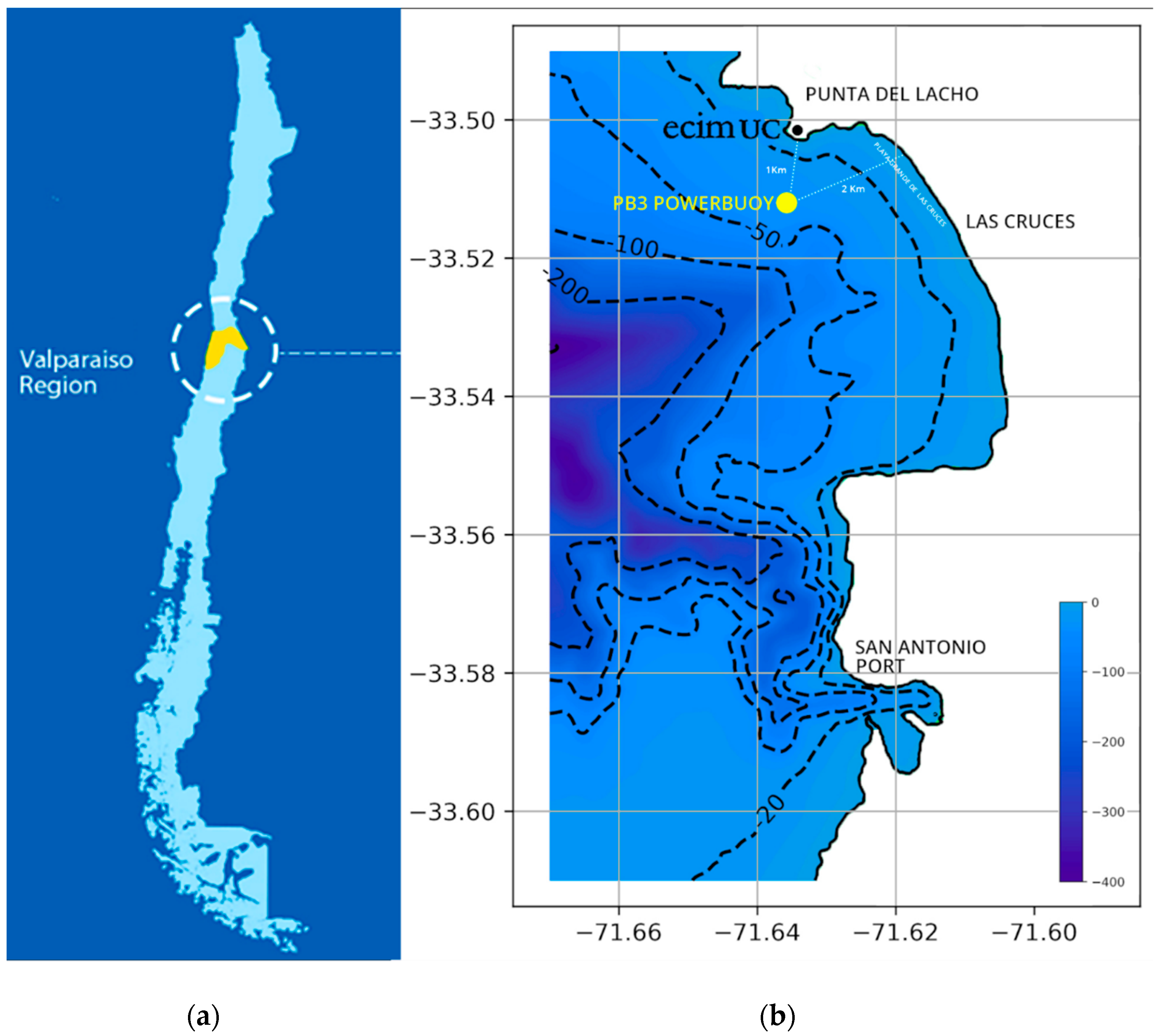
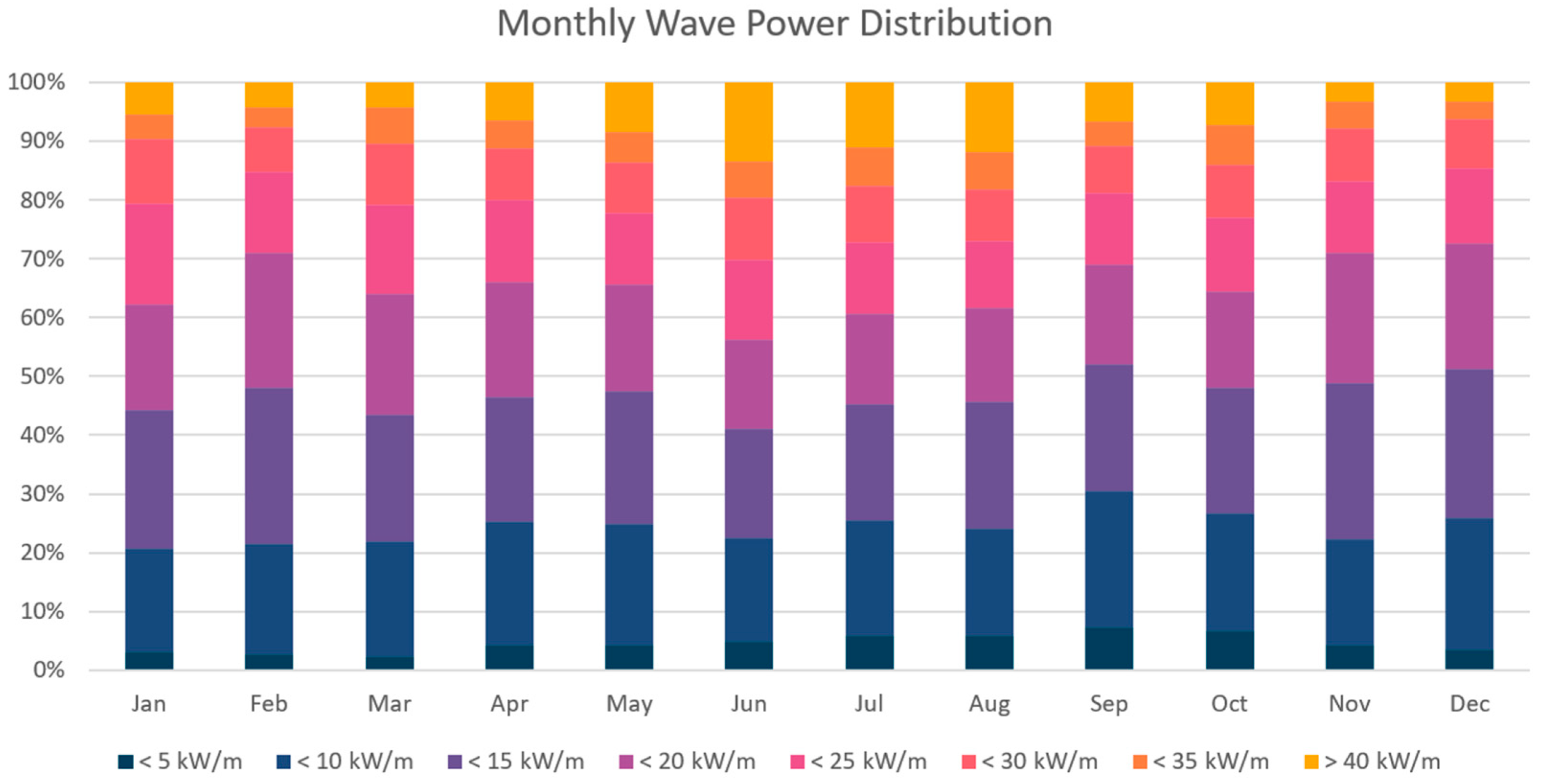
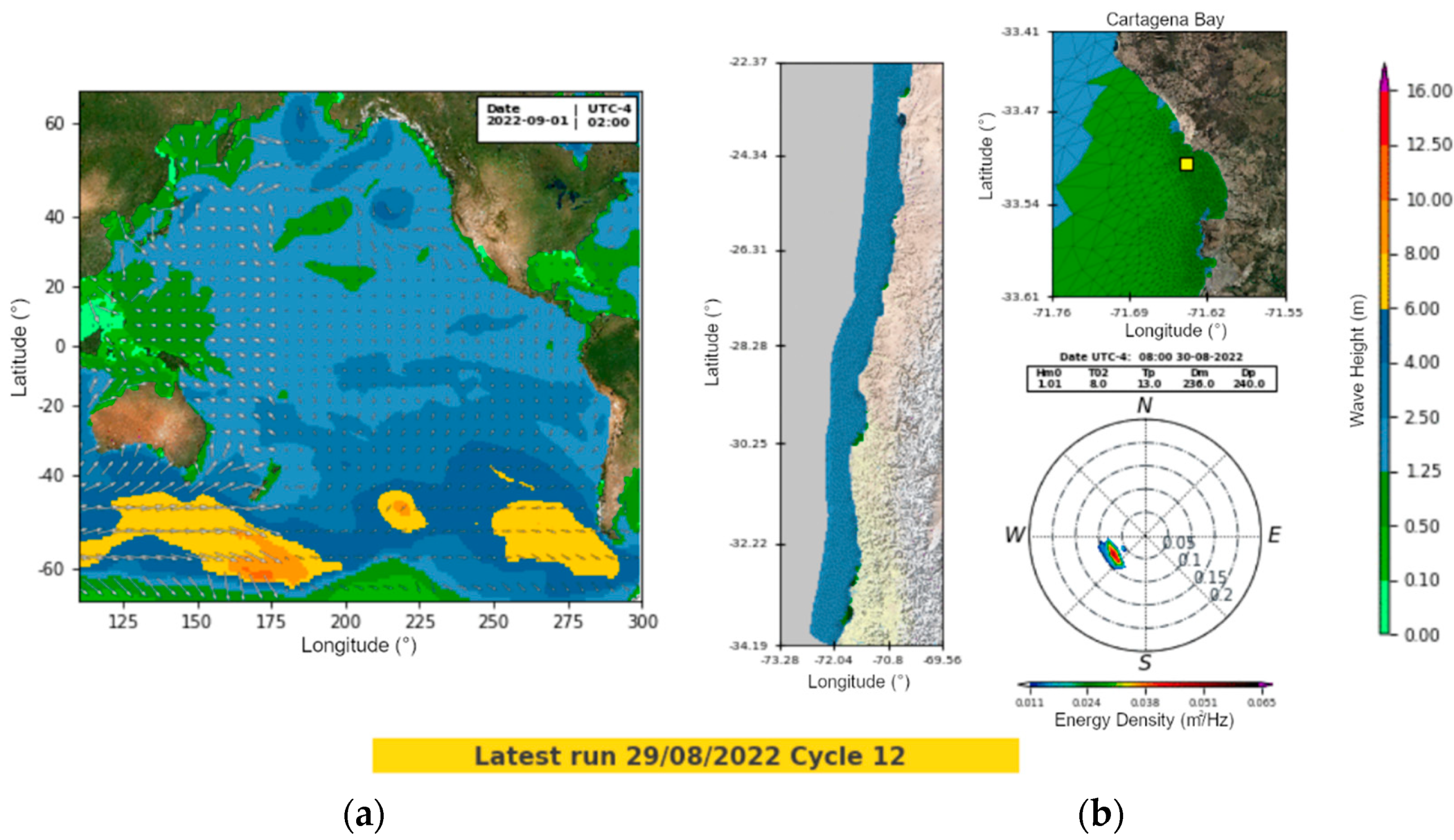
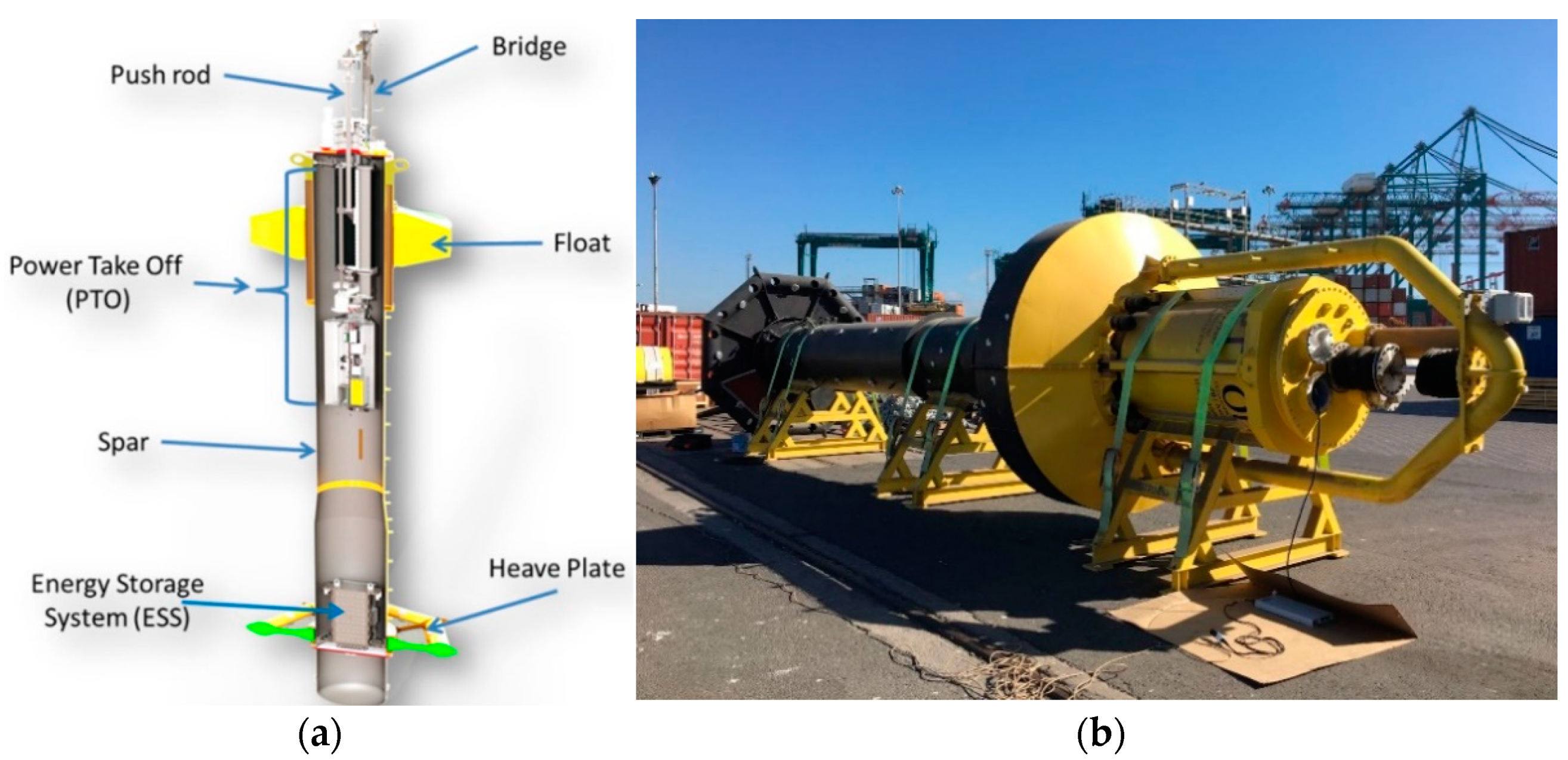
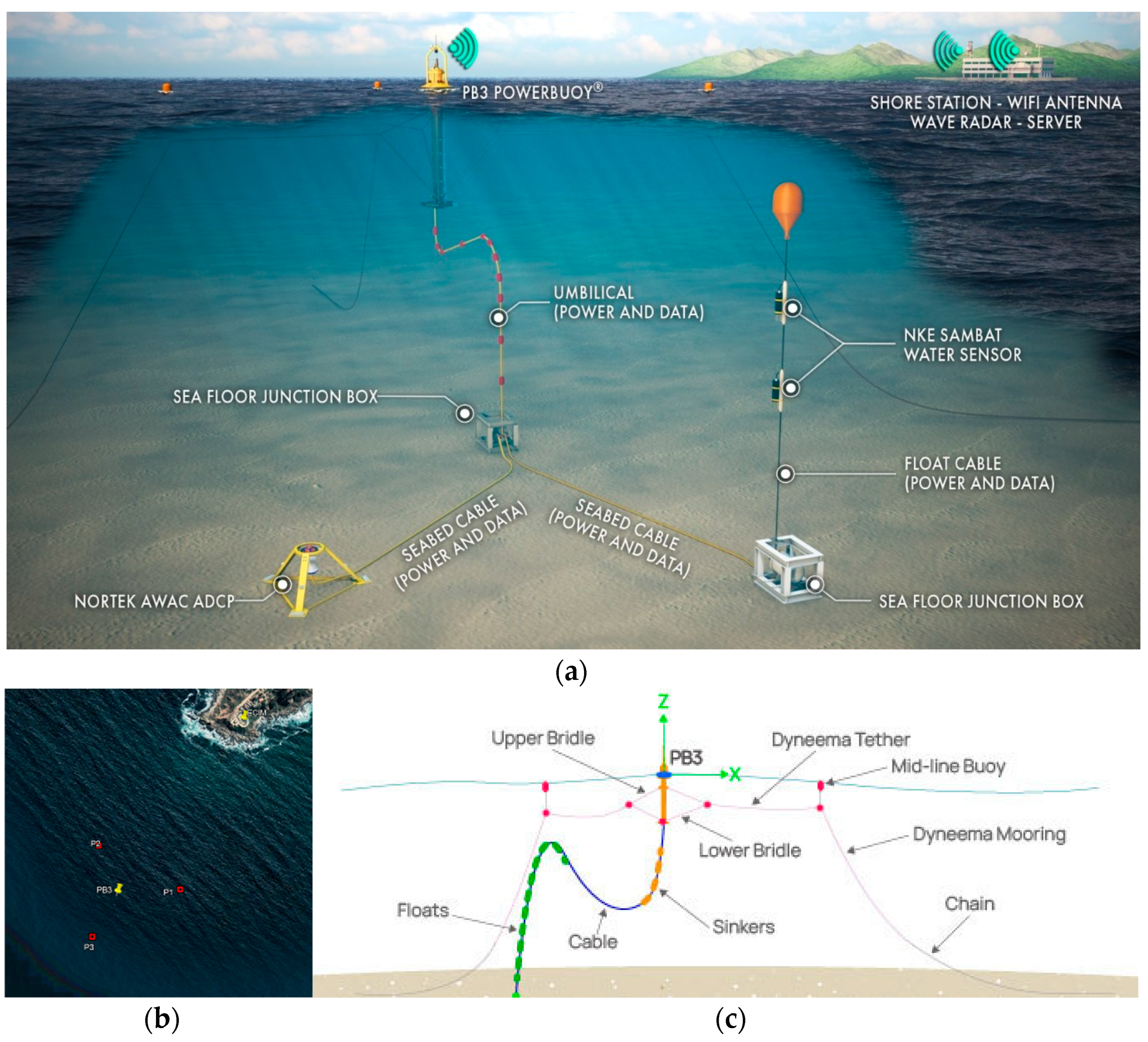

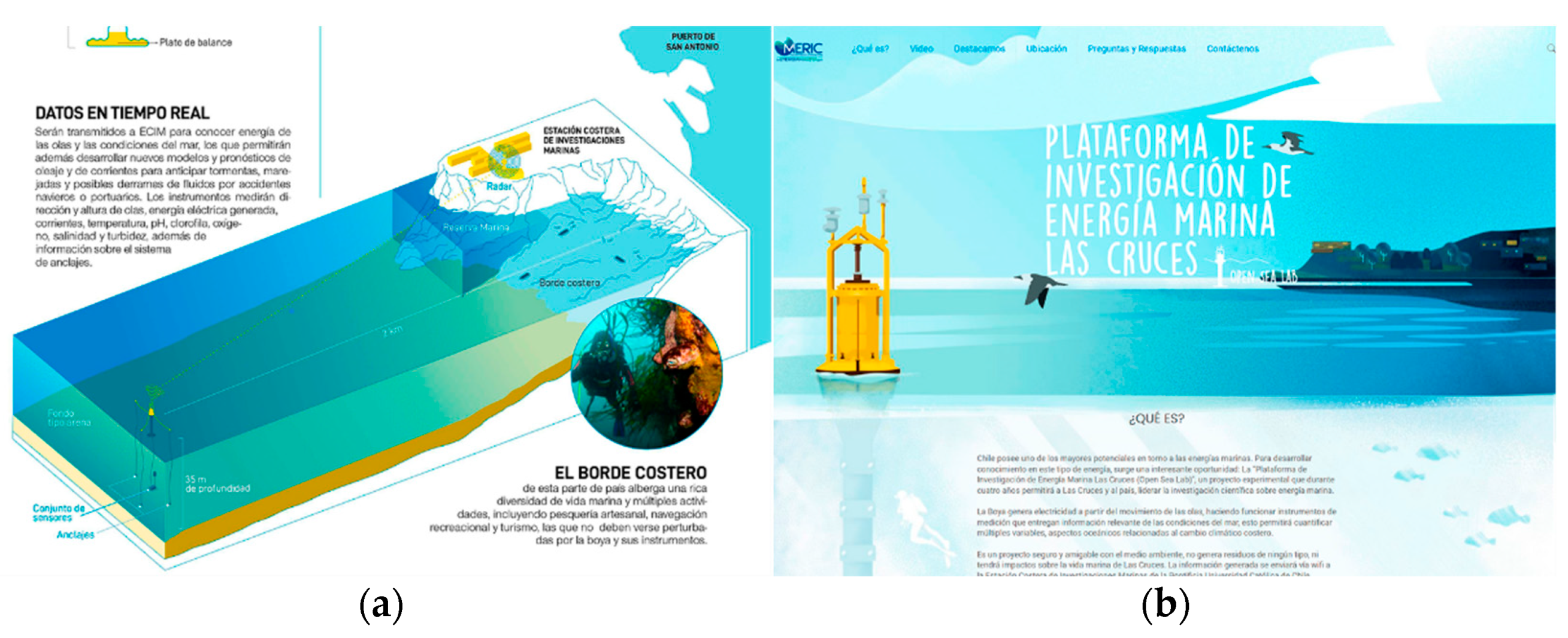
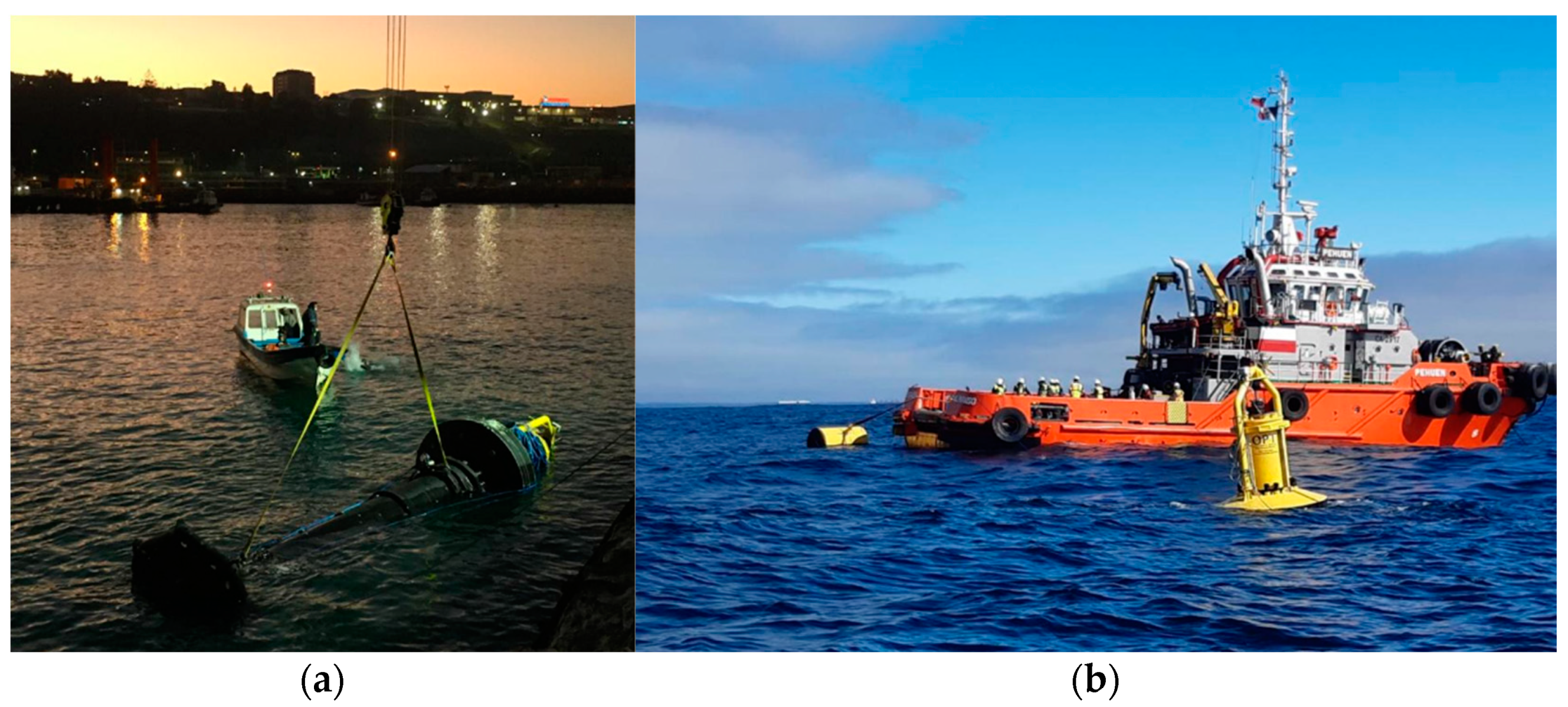
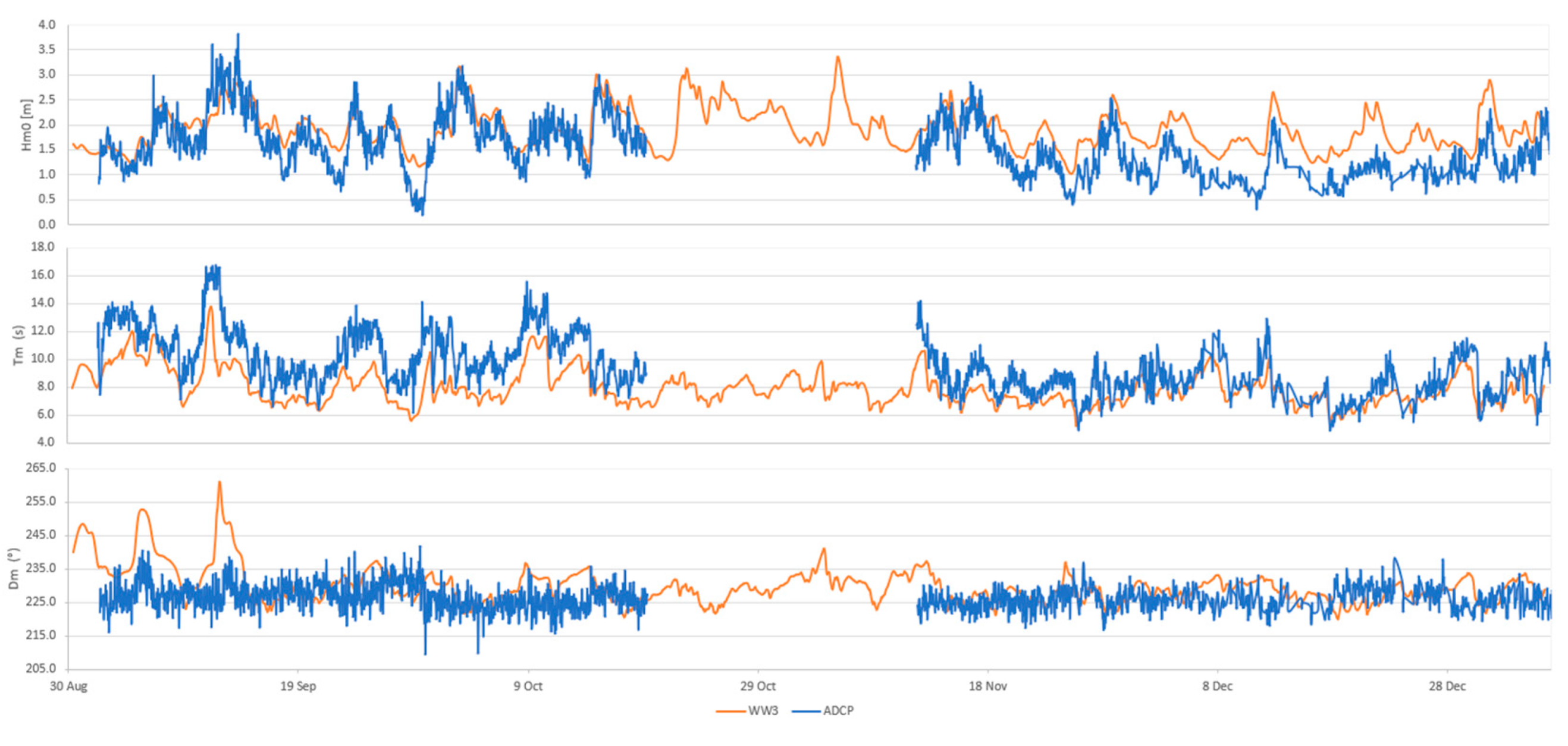
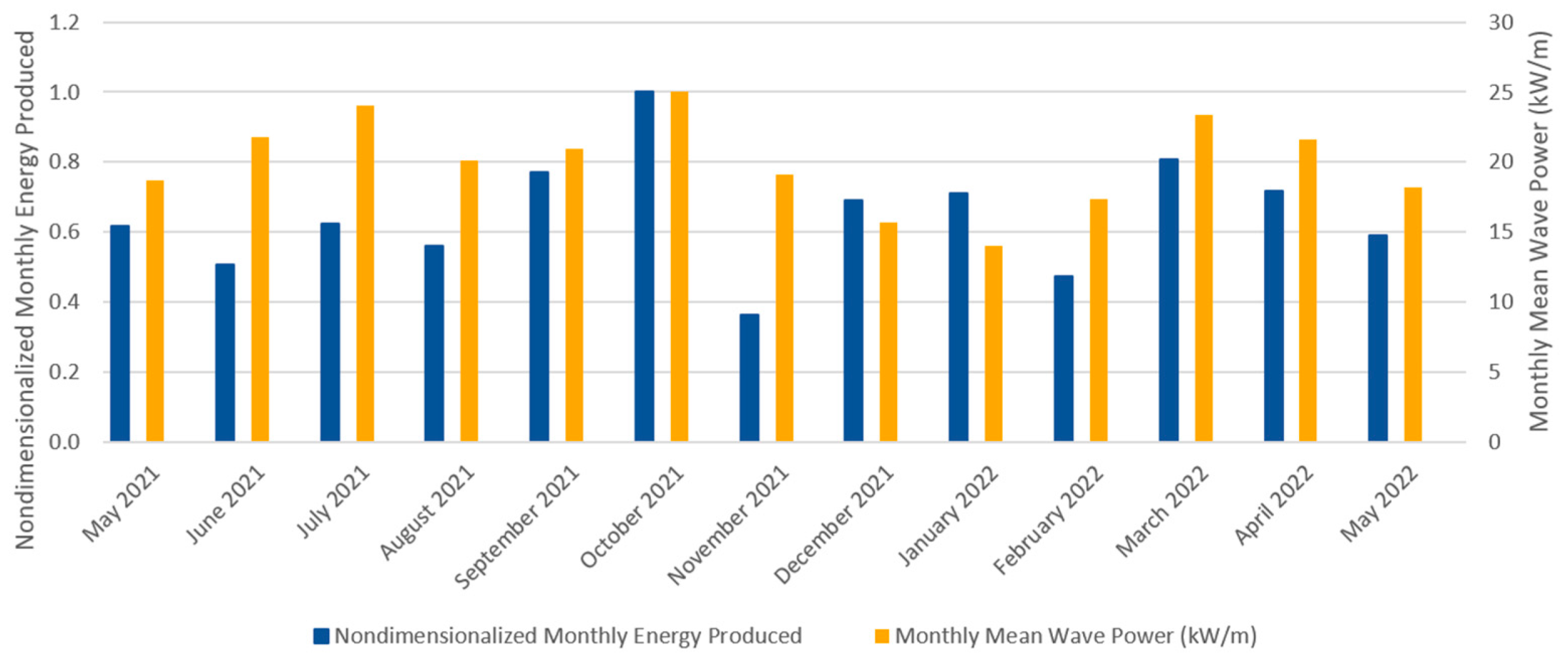

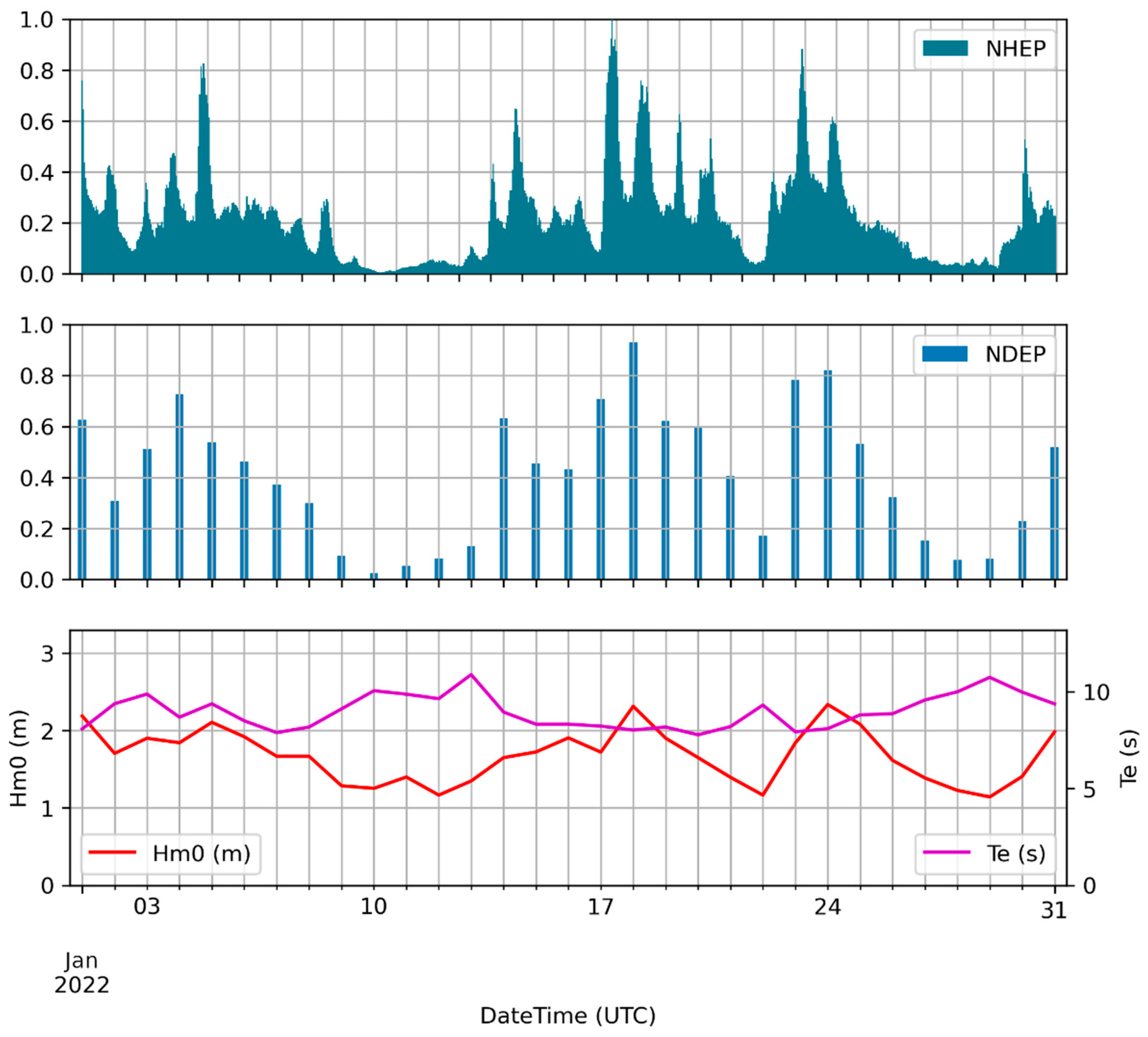
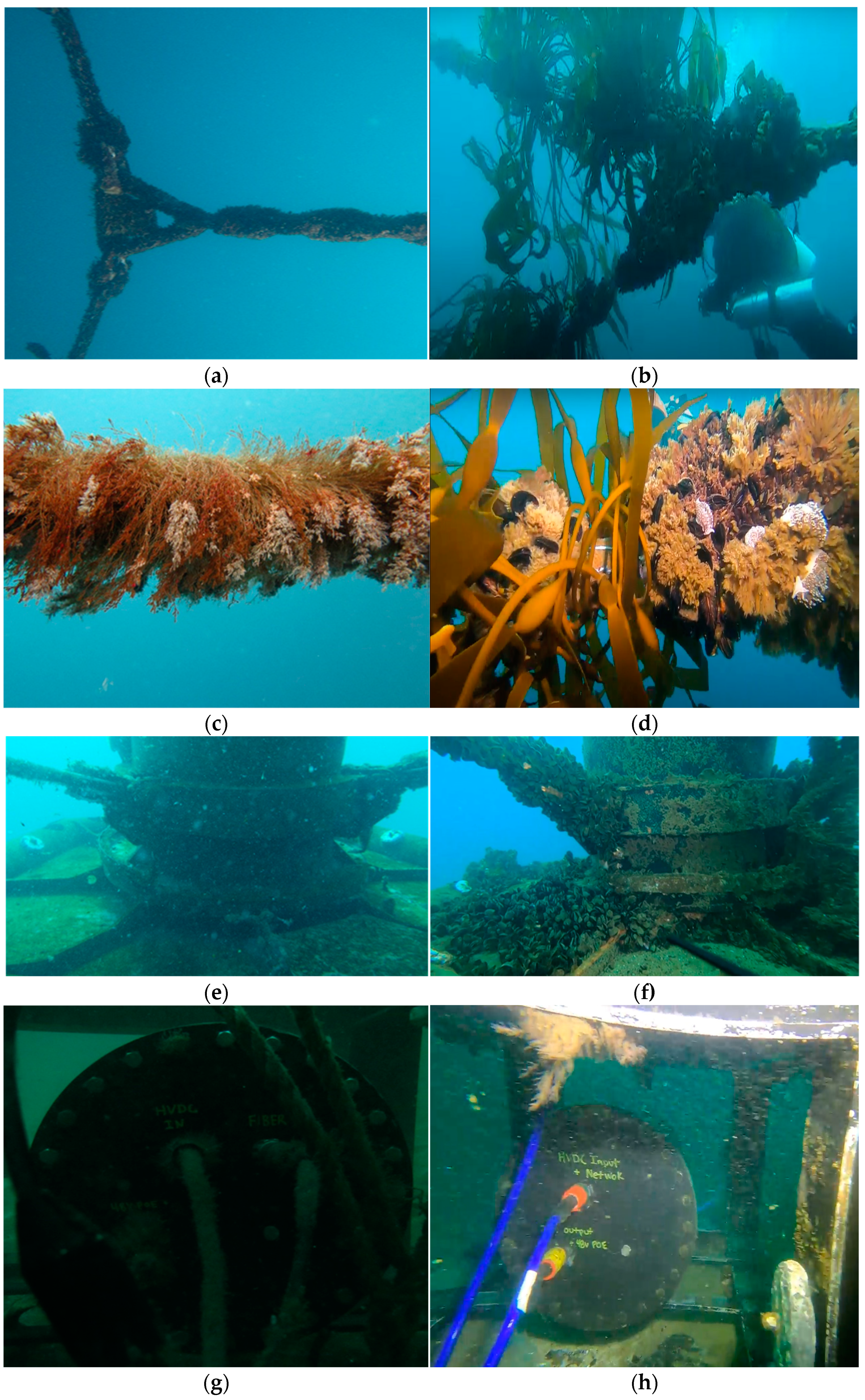
| Instrument | Manufacturer | Sampling Frequencies |
|---|---|---|
| ADCP AWAC 600 kHz | Nortek | 2 (Hz) |
| Water quality sensors | NKE Instrumentation | 2.5 (Hz) |
| Load pins | Strainstall | 1 (Hz) |
| Internal data PowerBuoy | Ocean Power Technologies | 2 (Hz) |
| Instrument | Company | Sampling Frequencies |
|---|---|---|
| Meteorological station | Atmos | Every 10 min |
| X-band radar with SeaDarQ V5 software | Nortek | Every 60 min |
Publisher’s Note: MDPI stays neutral with regard to jurisdictional claims in published maps and institutional affiliations. |
© 2022 by the authors. Licensee MDPI, Basel, Switzerland. This article is an open access article distributed under the terms and conditions of the Creative Commons Attribution (CC BY) license (https://creativecommons.org/licenses/by/4.0/).
Share and Cite
Cortés, J.; Lucero, F.; Suarez, L.; Escauriaza, C.; Navarrete, S.A.; Tampier, G.; Cifuentes, C.; Cienfuegos, R.; Manriquez, D.; Parragué, B.; et al. Open Sea Lab: An integrated Coastal Ocean Observatory Powered by Wave Energy. J. Mar. Sci. Eng. 2022, 10, 1249. https://doi.org/10.3390/jmse10091249
Cortés J, Lucero F, Suarez L, Escauriaza C, Navarrete SA, Tampier G, Cifuentes C, Cienfuegos R, Manriquez D, Parragué B, et al. Open Sea Lab: An integrated Coastal Ocean Observatory Powered by Wave Energy. Journal of Marine Science and Engineering. 2022; 10(9):1249. https://doi.org/10.3390/jmse10091249
Chicago/Turabian StyleCortés, Jaime, Felipe Lucero, Leandro Suarez, Cristian Escauriaza, Sergio A. Navarrete, Gonzalo Tampier, Cristian Cifuentes, Rodrigo Cienfuegos, Daniel Manriquez, Bárbara Parragué, and et al. 2022. "Open Sea Lab: An integrated Coastal Ocean Observatory Powered by Wave Energy" Journal of Marine Science and Engineering 10, no. 9: 1249. https://doi.org/10.3390/jmse10091249
APA StyleCortés, J., Lucero, F., Suarez, L., Escauriaza, C., Navarrete, S. A., Tampier, G., Cifuentes, C., Cienfuegos, R., Manriquez, D., Parragué, B., Osiadacz, N., & Finke, R. (2022). Open Sea Lab: An integrated Coastal Ocean Observatory Powered by Wave Energy. Journal of Marine Science and Engineering, 10(9), 1249. https://doi.org/10.3390/jmse10091249






